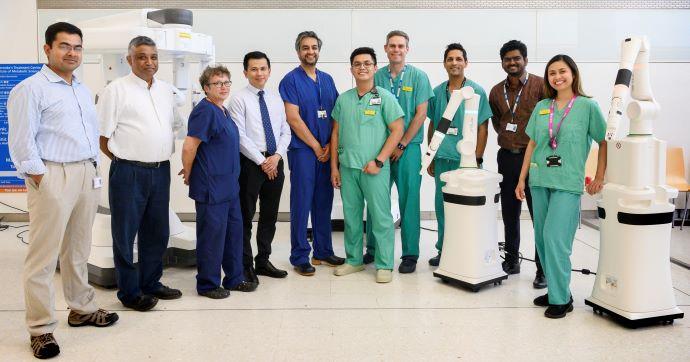Importantly, the robots enabled patients to recover faster from surgery, and allowed them to go home in hours or days - rather than weeks.
They have helped with a wide range of conditions, cut waiting lists, and fuelled ambitions for a fourth robot, which would make Addenbrooke’s one of the leading surgical centres in the UK.
The success was outlined today (5 July) - a year to the day after the Trust’s second robot was unveiled following a £1.5m fundraising campaign by Addenbrooke’s Charitable Trust (ACT).
The da Vinci Xi dual console surgical system has revolutionised patient care and surgical training across six specialties - urology, gynae-oncology, gynaecology, colorectal, ENT (ear, nose and throat) and HPB (Hepato-Pancreatico-Biliary - diseases of the liver, pancreas and biliary tree).
Chair of CUH Robotic Surgery Steering Group (RUG), Mr Siong-Seng Liau, said: “It has been an incredible 12 months during which we have treated hundreds of patients for a multitude of different conditions using techniques that often allow them to go home more quickly, freeing up beds for other patients who urgently need them.
“We are looking forward to the future with great confidence and, although it may be some way off, have ambitions to acquire a fourth robot and become the leading robotic surgical centre in the UK.”
ACT CEO, Shelly Thake, added: “It is important that all those who worked so hard to raise so much money are aware of just how impactful the robots have been for patients over the last 12 months. Once again, we want to thank them for their incredible support, this would not have been possible without them.”
The unveiling at Addenbrooke’s Treatment Centre was memorable as the robot cut its own ribbon in front of guests, coinciding with a host of other celebrations to mark the 75th anniversary of the NHS.
The fund-raising campaign was so successful it enabled the Trust to lease a third CMR Surgical Versius robot, allowing surgical teams to add further upper gastrointestinal, benign gynaecological and colorectal specialities to the service.
The two systems compliment Addenbrooke’s first robot, a Da Vinci Si, which was introduced over a decade ago to treat kidney, bladder, and prostate patients and was later upgraded to a Da Vinci Xi.
The CUH RUG group worked alongside ACT and the Trust to set-up the new services.
Involved were Mr Siong-Seng Liau (Chair of RUG)(HPB); Professor Grant Stewart (Previous Co-Chair), Mr Michael Powar (Colorectal); Miss Ekpemi Irune (ENT); Mr Liam Masterson (ENT); Mr Krishnayan Haldar (Gynae-oncology); Mr Saikat Banerjee (Gynaecology); Mr Simon Harper (HPB); Miss Alex Colquhoun (Urology); Atanul Pal (Colorectal).
The appeal ran over two years. Support came from the Cambridge Independent and many groups and individuals, including CUH surgeon, Atanu Pal, who took part in the virtual London Marathon in 2021, running a route that spelled out the word ROBOT.
The Cambridgeshire Vintage Tractor Club rallied more than 100 tractors to drive through South Cambridgeshire villages, and Frances Dewhurst challenged herself to walk up her stairs ten times a day for 100 days, in memory of her late sisters, Hilary and Charlotte.
Anyone interested in supporting ACT’s can find more about its work here.
Mr David Power – a case study
Retired shop manager, Mr David Power, wouldn’t hesitate recommending robot surgery to a friend.
Because thanks to surgeon Mr Siong-Seng Liau, and the new da Vinci robot, he was able to return home the next day, rather than the seven to 10 days required had he undergone traditional open surgery.
Mr Power, who worked for many years in the furniture sector, was referred to Addenbrooke’s by his GP after complaining of a swelling in his stomach that increased over 12 months, and was causing an uncomfortable sense of “fullness”.
Further investigations confirmed a very large liver cyst and shortly after Mr Liau removed it with the help of the robot and theatre colleagues, having first drained 2.7 litres of fluid – which is more than 4.7 pints.
The next day Mr Power, who was considerably lighter and two belt notches thinner, was back at his home near Haverhill with wife Stephanie, and his second love - a model railway housed in a 6x3m purpose-built ‘station’ in his back garden.
Mr Power, who also has a passion for photography, said: “My advice to anyone feeling anxious about robot surgery is don’t be. Mine was all very straight forward, and by the next day I was back home, feeling fitter, and getting on with my retirement.
“I was soon back to working on the railway layout, and out and about photographing landscapes and interesting architecture.”
Mr Liau said: “The conventional way of doing this surgery is traditionally difficult, involving a very large open operation, after which the patient can typically expect to be in hospital for up to seven to ten days.
“It was great news that Mr Power was able to benefit from robot surgery, and was back home so quickly to enjoy his retirement. We wish him all the best for the future.”



